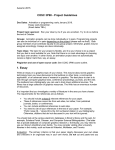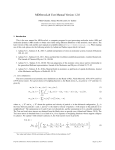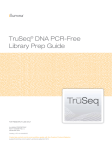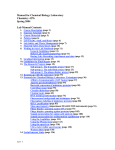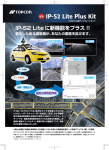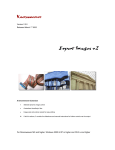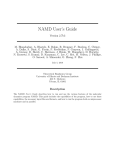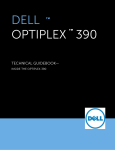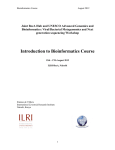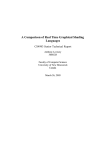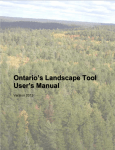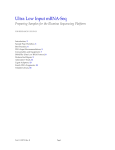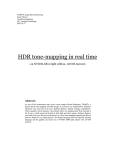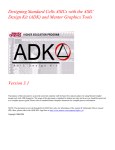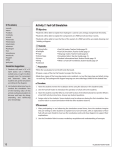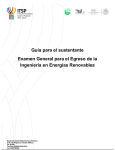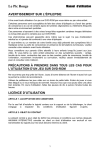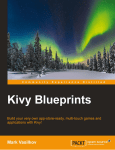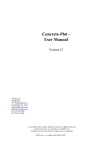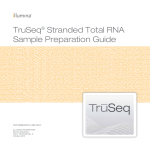Download Practical 10: Protein dynamics and visualization
Transcript
Practical 10: Protein dynamics and visualization Documentation Release 1.0 Oliver Beckstein March 07, 2013 CONTENTS 1 Basics of protein structure 3 2 Analyzing protein structure and topology 2.1 Topology and 2ndary structure . . . . . . . . . . . . . . . . . . . . . . . . . . . . . . . . . . . . . . 2.2 Exercises . . . . . . . . . . . . . . . . . . . . . . . . . . . . . . . . . . . . . . . . . . . . . . . . . 5 5 5 3 Publication-quality images 11 4 Analyzing protein dynamics 4.1 Visualization . . . . . . . . . . . . . . . . . . . . . . . . . . . . . . . . . . . . . . . . . . . . . . . 4.2 RMSD change . . . . . . . . . . . . . . . . . . . . . . . . . . . . . . . . . . . . . . . . . . . . . . 4.3 Measuring distances . . . . . . . . . . . . . . . . . . . . . . . . . . . . . . . . . . . . . . . . . . . 13 13 13 13 5 Making movies in VMD 5.1 Install the ffmpeg encoder . . . . . . . . . . . . . . . . . . . . . . . . . . . . . . . . . . . . . . . . 5.2 AdK transition movie . . . . . . . . . . . . . . . . . . . . . . . . . . . . . . . . . . . . . . . . . . 5.3 Advanced movie making . . . . . . . . . . . . . . . . . . . . . . . . . . . . . . . . . . . . . . . . . 15 15 15 16 6 Learning Objectives 17 7 References 19 8 Indices and tables 21 Bibliography 23 Index 25 i ii Practical 10: Protein dynamics and visualization Documentation, Release 1.0 For background on using VMD, look at [Hsin2008] and the VMD tutorial. Basics of protein structure are illustrated in [BrandenTooze]. Contents: CONTENTS 1 Practical 10: Protein dynamics and visualization Documentation, Release 1.0 2 CONTENTS CHAPTER ONE BASICS OF PROTEIN STRUCTURE See also illustrations in slides and [BrandenTooze]. Introduction to protein structure • polypeptides, amino acids – chemical structure of the 20 aa – natural aa: L-form (note: look down H-Ca and read CORN == L, otherwise D) – peptide bond – repeating unit: residue, same backbone, differing sidechain R – sequence, primary structure • hydrogen bonds: donor-H...acceptor • secondary structure – alpha-helix (n..n+4 H-bonds of main chain, ~3.6 res per turn) * peptide units: phi, psi angles: flexible, omega (peptide bond) fixed (cis/trans) * must be right handed (otherwise clashes; only very short helices are left-handed) – beta sheet (extended), parallel/anti-parallel – (coiled coil) – 3-10 helix (n..n+3, 10 atoms between donor and acceptor, 3 res per turn) – pi helix (n..n+5) • tertiary structure: - helices - sheets - hairpins, loops - coiled-coil • quaternary structure 3 Practical 10: Protein dynamics and visualization Documentation, Release 1.0 4 Chapter 1. Basics of protein structure CHAPTER TWO ANALYZING PROTEIN STRUCTURE AND TOPOLOGY Use VMD to learn more about a protein. The example we use is adenylate kinase (“AdK”). For background on using VMD, look at [Hsin2008] and the VMD tutorial. 2.1 Topology and 2ndary structure • get adk_open.pdb from http://becksteinlab.physics.asu.edu/pages/courses/2013/SimBioNano/09/ • settings in VMD: – Display -> Orthographic – Display -> Rendermode: GLSL – Graphics -> Color: Display: Background: White • select protein • new cartoon representation, color by secondary structure 2.2 Exercises 2.2.1 Identify secondary structure and topology Sketch a topology diagram on paper (use open structure for analysis): • number helices H1 - H8 (ignore short < 4 res, count all helices as helix, alpha, pi, 3-10) • sheets A, B, C, number strands SA1-SA5, SB1-3, SC1-2 • start with central b-sheet • locate N-terminus (resid 1 and name CA, color blue, VDW) and C terminus Note: You can do ranges: resid 1 to 5 or multiple ranges: resid 1 to 5 20 to 50. You can use boolean operators and, or, not. See selections in the user manual for details. • draw connections between secondary elements in your topology diagram and label secondary structure elements. 5 Practical 10: Protein dynamics and visualization Documentation, Release 1.0 Topology of AdK C2 C3 C1 B1 B2 H6 C1 H6 H7 C3 B1 B2 H7 H3 C2 H1 A1 A2 A1 H5 A2 A3 A4 A5 H8 C H4 H2 H3 H1 N H2 A4 A5 H8 H7 H5 H4 Figure 2.1: Topology diagram of AdK. 2.2.2 Identify domains (tertiary structure) • compare to closed conformation – load adk_closed.pdb – select protein – new cartoon, color differently from the open structure – superimpose: Extensions -> Analysis -> RMSD tool: protein v u N u1 X RMSD = t (xa,i − xb,i )2 N i=1 What is the RMSD after superposition? – Investigate how the conformation of the molecule changes. * Which regions (domains) “move”? * Identify two moving domains (called “NMP” and “LID”) and one constant region (“CORE”): · give residue ranges (tip: use Extensions -> Analysis -> Sequence Viewer) · color regions differently and also mark them in your topology diagram – align on CORE domain only What is the final RMSD when aligned on CORE only, i.e. how similar are the CORE regions in the two structures? What is the overall protein RMSD, assuming that the two structures are superimposed on CORE? 6 Chapter 2. Analyzing protein structure and topology Practical 10: Protein dynamics and visualization Documentation, Release 1.0 2.2.3 Ligands • Download 1AKE from the PDB (or use 1ake.pdb from the course directory) • show protein chain A • show the co-crystallized ligand Ap5 (resname AP5") – resname AP5, licorice, color: name • show charged residues within 5 Å of the ligand – same residue as (charged and within 5 of resname AP5) – use representation licorice, color: name for the residues, make ligand VDW. – Which side chains make contact with the ligand? – What have they got in common? (Tip: try out color: restype) • water – show crystal water oxygens as VDW or licorice (small spheres) 2.2.4 Summary AdK secondary and tertiary structure AdK is a dynamic enzyme, which can undergo a large conformational change between an open and a closed conformation. The backbone RMSD between the two conformations is about 7.16 Å. AdK contains a central beta sheet (with strands A1 to A5) between four helices (H1, H5, H7, H8), making up the CORE domain (residues 1-29, 60-121, 160-214). This CORE domain does not change much between the open and closed conformation (RMSD 1.97 Å of CORE). The NMP domain, consisting of helices H2—H4 (residues 30-59), and the LID domain (H6 and two small beta sheets B1/B2 and C1/C2/C3, resids 122-159) are very mobile. On closing, the both fold towards CORE on hinges. When RMS-fitted on CORE, the overall RMSD is 8.0 Å. AdK Ligand The AP5 ligand mimics the transition state of the phospho-transfer reaction. Phosphates are negatively charged, hence only basic (positively charged, blue) residues are in contact. 2.2. Exercises 7 Practical 10: Protein dynamics and visualization Documentation, Release 1.0 Topology of AdK C2 C3 C1 B1 B2 H6 B2 C1 H6 H7 C3 B1 H3 C2 H1 A1 A2 A1 H5 A2 A3 H8 C H7 A4 A5 H4 H1 N H2 H3 H2 A4 A5 H8 H7 H5 H4 Figure 2.2: Topology diagram of AdK. 8 Chapter 2. Analyzing protein structure and topology Practical 10: Protein dynamics and visualization Documentation, Release 1.0 2.2. Exercises 9 Practical 10: Protein dynamics and visualization Documentation, Release 1.0 10 Chapter 2. Analyzing protein structure and topology CHAPTER THREE PUBLICATION-QUALITY IMAGES To make an image with AO (ambient occlusion lighting) and depth cueing: • Settings – Display -> Rendermode -> GLSL – Display -> Display Settings: * Shadows On, * Amb Occl On * Cue Mode: Linear * Cue start: 1.75 * Cue end: 3.0 – white bg: Graphics -> Colors: Display : White • rendering: File -> Render – snapshot * glossy material looks nice – tachyon (internal): ray tracer (takes a while due to AO) * change materials to special AO materials (e.g. AOChalky) 11 Practical 10: Protein dynamics and visualization Documentation, Release 1.0 Figure 3.1: Example (AdK) was rendered with Tachyon (internal) with VDW representation, colors silver, yellow, and blue, no depth cueing, material AOChalky, and using Ambient Occlusion (AO) and Shadows (see Display → Displaysettings) 12 Chapter 3. Publication-quality images CHAPTER FOUR ANALYZING PROTEIN DYNAMICS Analyze a trajectory of the closed-to-open transition of AdK [Beckstein2009]: 4.1 Visualization • load adk.psf with adk_dims.dcd (use load all at once, this is faster in general) • color domains and show as new cartoon – resid 30 to 59: blue – resid 122 to 159: yellow – not (resid 30 to 59 122 to 159) (or resid 1 to 29 60 to 121 160 to 214): gray • play (loop: rock) 4.2 RMSD change • RMSD change over the trajectory: Extensions/Analysis/RMSD Trajectory Tool • Is the result consistent with the result of your RMSD analysis of the static structures? 4.3 Measuring distances Measure distances interactively: • ‘2’ (or Mouse -> Label -> Bonds) • click tip of LID and tip of NMP • play the trajectory: label changes dynamically • Graphics -> Labels: Bonds - select - Graph (preview) - Graph... • try different distances between residues (use the CA) and plot together: which change, which don’t? – What would be good distances to report on conformational changes, e.g. for FRET? 13 Practical 10: Protein dynamics and visualization Documentation, Release 1.0 14 Chapter 4. Analyzing protein dynamics CHAPTER FIVE MAKING MOVIES IN VMD 5.1 Install the ffmpeg encoder The iMAcs are not well equipped for movie making so we need to install the ffmpeg encoder from http://becksteinlab.physics.asu.edu/pages/courses/2013/SimBioNano/10/ffmpeg/ cd ~/bin curl -O http://becksteinlab.physics.asu.edu/pages/courses/2013/SimBioNano/10/ffmpeg/ffmpeg chmod a+x ffmpeg Then make sure that ffmpeg is found on your PATH: echo "export PATH=$HOME/bin:$PATH" >> ~/.profile (You might have to log out and log in for this to have full effect later on.) 5.2 AdK transition movie We use the standard VMD plugin MovieMaker. 1. Load the AdK transition trajectory from Analyzing protein dynamics. 2. Use a nice representation, e.g. color the CORE, LID, and NMP domains. You can also find a number of salt bridges (pairs of basic/positively charged and acidic/negatively charge residues) that “zip up” AdK (see the AdK zipping movie from Beckstein et al). 3. Open Extension -> Visualization -> Movie Maker 4. Settings • Renderer: Snapshot (for “Hollywood”-style movies, use one of the ray tracers such as tachyon + AO) • Movie Settings: Trajectory • Set Format to MPEG-1 (ffmpeg). (MPEG-2 is better but the iMacs can’t display it). • Set your working directory to e.g. ~/USERNAME/p10/movies (so that you can easily find the finished movie) • Name your movie, e.g. adk_transition. 5. Make Movie: should step through your trajectory, write out frames, and finally run ffmpeg. 6. In the shell, go to your movie directory and play it: 15 Practical 10: Protein dynamics and visualization Documentation, Release 1.0 open adk_transition.mpg 5.3 Advanced movie making In order to rotate and zoom a movie during a trajectory we can use the VMD ViewChangeRender plugin together with MovieMaker. Open ViewChangeRender Extensions -> Visualization -> ViewChangeRender. Generate “viewpoints” of your movie: 1. Adjust position in trajectory, rotate, zoom. 2. Save Viewpoint Repeat for as many viewpoints as you want to include. Add all viewpoints to movie: The final movie will smoothly interpolate between these points. You can check with Preview Movie. (Note that this plugin has a few bugs so you might have to quit and restart when it stops working.) Once you are ready to render the movie: 1. In ViewChangeRender: Enable 2. In MovieMaker: (a) Movie Settings: User defined procedure (b) Adjust other settings as needed... (c) Make movie 16 Chapter 5. Making movies in VMD CHAPTER SIX LEARNING OBJECTIVES • basic understanding of protein structure • familiarize with a molecular graphics program (VMD) • loading of static structures and dynamics trajectories • viewing a molecule (mouse, view modes) • representations • selections • making images • basic analysis • use of RMSFitting tools 17 Practical 10: Protein dynamics and visualization Documentation, Release 1.0 18 Chapter 6. Learning Objectives CHAPTER SEVEN REFERENCES 19 Practical 10: Protein dynamics and visualization Documentation, Release 1.0 20 Chapter 7. References CHAPTER EIGHT INDICES AND TABLES • genindex • modindex • search 21 Practical 10: Protein dynamics and visualization Documentation, Release 1.0 22 Chapter 8. Indices and tables BIBLIOGRAPHY [BrandenTooze] C. Branden and J. Tooze. Introduction to Protein Structure. 2nd ed, 1999, Garland Publishing, New York. [Hsin2008] J. Hsin, A. Arkhipov, Y. Yin, J. E. Stone, and K. Schulten. Using VMD: An Introductory Tutorial, volume 24, chapter 5.7, pages 5.7.1–5.7.48. John Wiley & Sons, Inc., 2008. URL http://dx.doi.org/10.1002/0471250953.bi0507s24. [Beckstein2009] O Beckstein. EJ Denning, JR Perilla, and TB Woolf. Zipping and Unzipping of Adenylate Kinase: Atomistic Insights into the Ensemble of Open/Closed Transitions. J Mol Biol 394 (2009), 160–176. http://dx.doi.org/10.1016/j.jmb.2009.09.009 23 Practical 10: Protein dynamics and visualization Documentation, Release 1.0 24 Bibliography INDEX E environment variable PATH, 15 P PATH, 15 25





























